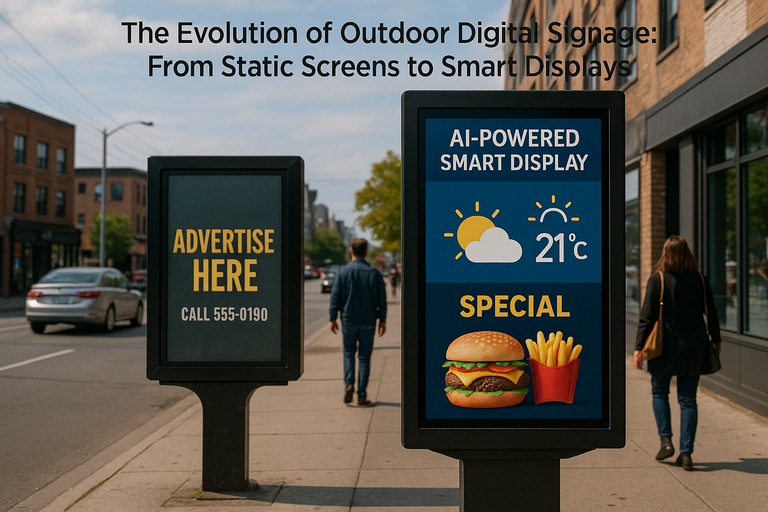Key Takeaway
Digital signage displays are purpose-built for 24/7 operation with advanced management features, while consumer TVs offer cost-effective solutions for smaller deployments with shorter operational hours.
Digital Signage Display vs TV: Understanding the Differences
| Feature | Digital Signage Displays | Consumer TVs |
|---|---|---|
| Operational Hours | Designed for 16-24 hours continuous operation | Typically 8-12 hours daily use |
| Durability | Commercial-grade components, rugged construction | Consumer-grade components, standard construction |
| Orientation Support | Optimized for portrait and landscape modes | Limited portrait mode support (heat issues) |
| Remote Management | Advanced network control and monitoring | Basic remote control functionality |
| Warranty | 3-5 years commercial warranty | 1-2 years consumer warranty (voided in commercial use) |
| Cost | 2-4x more expensive than consumer TVs | Affordable, widely available |
| Lifespan | 8-12 years with proper maintenance | 3-5 years in commercial environments |
| Ventilation | Enhanced cooling systems for extended use | Standard cooling, may overheat in portrait mode |
Digital Signage Displays: Pros and Cons
✅ Advantages
- 24/7 Operation: Built for continuous use without overheating
- Portrait Mode Support: Proper ventilation for vertical orientation
- Remote Management: Network-based control and monitoring
- Commercial Warranty: 3-5 years coverage for business use
- Durability: Rugged construction for commercial environments
- Advanced Features: Built-in media players, scheduling, and analytics
- Longer Lifespan: 8-12 years with proper maintenance
❌ Disadvantages
- High Cost: 2-4x more expensive than consumer TVs
- Limited Selection: Fewer models and brands available
- Complex Setup: May require professional installation
- Technology Lag: May not have latest consumer features
- Limited Availability: Not available at retail stores
Consumer TVs: Pros and Cons
✅ Advantages
- Cost-Effective: Significantly lower upfront investment
- Wide Availability: Easy to find and purchase
- Latest Technology: Access to newest display features
- Familiar Interface: Standard TV controls and settings
- Quick Deployment: Plug-and-play setup
- Replacement Parts: Easy to find spare components
❌ Disadvantages
- Limited Operational Hours: Not designed for 24/7 use
- Portrait Mode Issues: Heat buildup in vertical orientation
- Voided Warranty: No warranty coverage in commercial settings
- Shorter Lifespan: 3-5 years in commercial environments
- Basic Management: Limited remote control capabilities
- Consumer Components: Not built for commercial durability
When to Choose Digital Signage Displays
🏢 High-Traffic Commercial Environments
Choose digital signage displays for retail stores, airports, hospitals, and other high-traffic areas where displays run continuously and need to withstand heavy use.
📊 Portrait Mode Applications
Digital signage displays are essential for portrait orientation installations, as they have proper ventilation systems that prevent heat buildup in vertical configurations.
🌐 Multi-Location Networks
For businesses managing multiple displays across different locations, digital signage displays offer superior remote management capabilities and centralized control.
⏰ 24/7 Operation Requirements
When your displays need to operate continuously without breaks, digital signage displays are designed for this purpose with enhanced cooling and durability.
When to Choose Consumer TVs
💰 Budget-Conscious Deployments
For smaller businesses or organizations with limited budgets, consumer TVs offer a cost-effective way to implement digital signage without the premium price tag.
🏫 Educational Institutions
Schools and universities often choose consumer TVs for digital signage due to budget constraints, especially when displays are used for limited hours each day.
🏠 Small Business Applications
Small retail stores, restaurants, and offices can benefit from consumer TVs for basic digital signage needs without the complexity and cost of commercial displays.
🧪 Testing and Prototyping
Consumer TVs are ideal for testing digital signage concepts before investing in commercial-grade equipment.
Real-World Insights from IT Professionals
- Cost vs. Performance: "If I had bought commercial grade, I could have only bought a dozen for the same money that bought 60+ consumer units." - IT Administrator
- Durability: "I had a ceiling tile rain water over one of our Sharp Commercial displays. It still works. It's gotta be close to ten years old now." - System Administrator
- Technology Evolution: "Spend less; replace more often. It's environmentally wasteful, but sound advice because the tech moves too fast." - IT Professional
- Warranty Considerations: "Just remember that a consumer TV once it walks into your building there is no warranty." - IT Administrator
Making the Right Choice: Decision Framework
Consider Digital Signage Displays If:
- Your displays will operate more than 12 hours per day
- You need portrait mode orientation
- You're managing multiple locations
- You require advanced remote management features
- You have a budget for premium equipment
- You need 3+ years of reliable operation
Consider Consumer TVs If:
- Your displays operate less than 8 hours per day
- You have a limited budget
- You're testing or prototyping
- You need quick deployment
- You're in a small business environment
- You can accept shorter equipment lifespan
Hybrid Approach: Best of Both Worlds
Many organizations adopt a hybrid approach, using digital signage displays for critical, high-traffic areas and consumer TVs for secondary locations or testing purposes. This strategy allows you to:
- Optimize costs while maintaining reliability where it matters most
- Test new concepts with affordable consumer equipment
- Gradually upgrade to commercial displays as budgets allow
- Maintain flexibility for different use cases
Conclusion
The choice between digital signage displays and consumer TVs ultimately depends on your specific requirements, budget, and operational needs. Digital signage displays offer superior durability and management capabilities but come with a higher price tag. Consumer TVs provide cost-effective solutions for smaller deployments but may not withstand the rigors of commercial use.
By carefully evaluating your operational hours, orientation requirements, budget constraints, and management needs, you can make an informed decision that balances cost-effectiveness with reliability and performance.
Final Recommendation
For most commercial applications, digital signage displays are the safer long-term investment. However, consumer TVs can be an excellent choice for smaller deployments, testing environments, or organizations with strict budget constraints.



